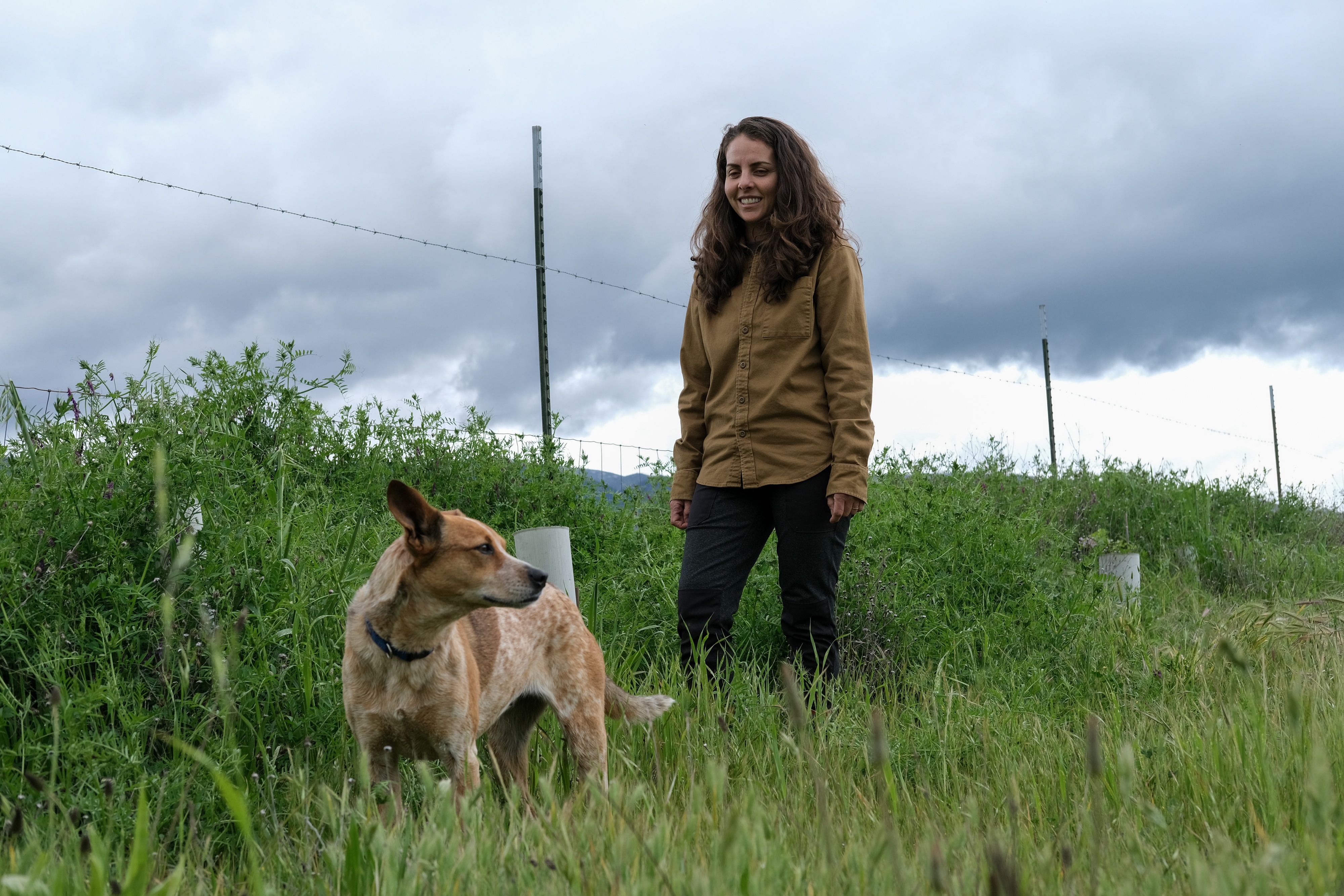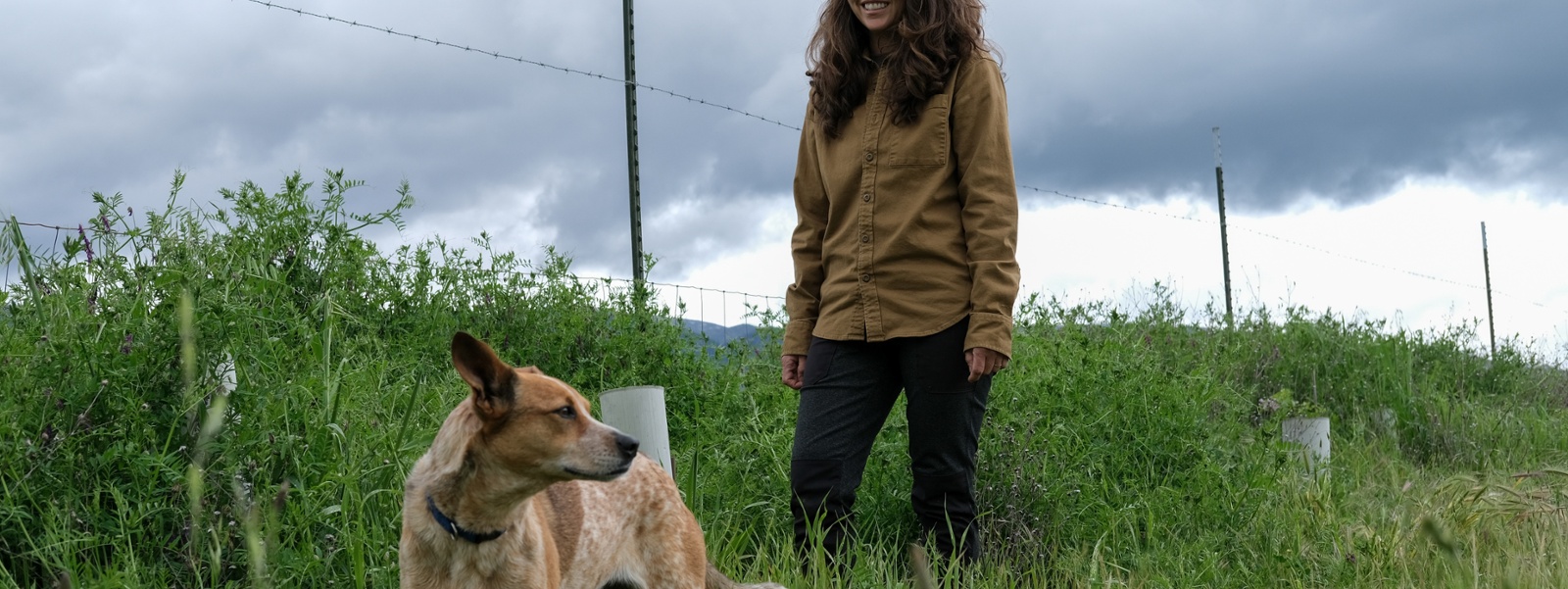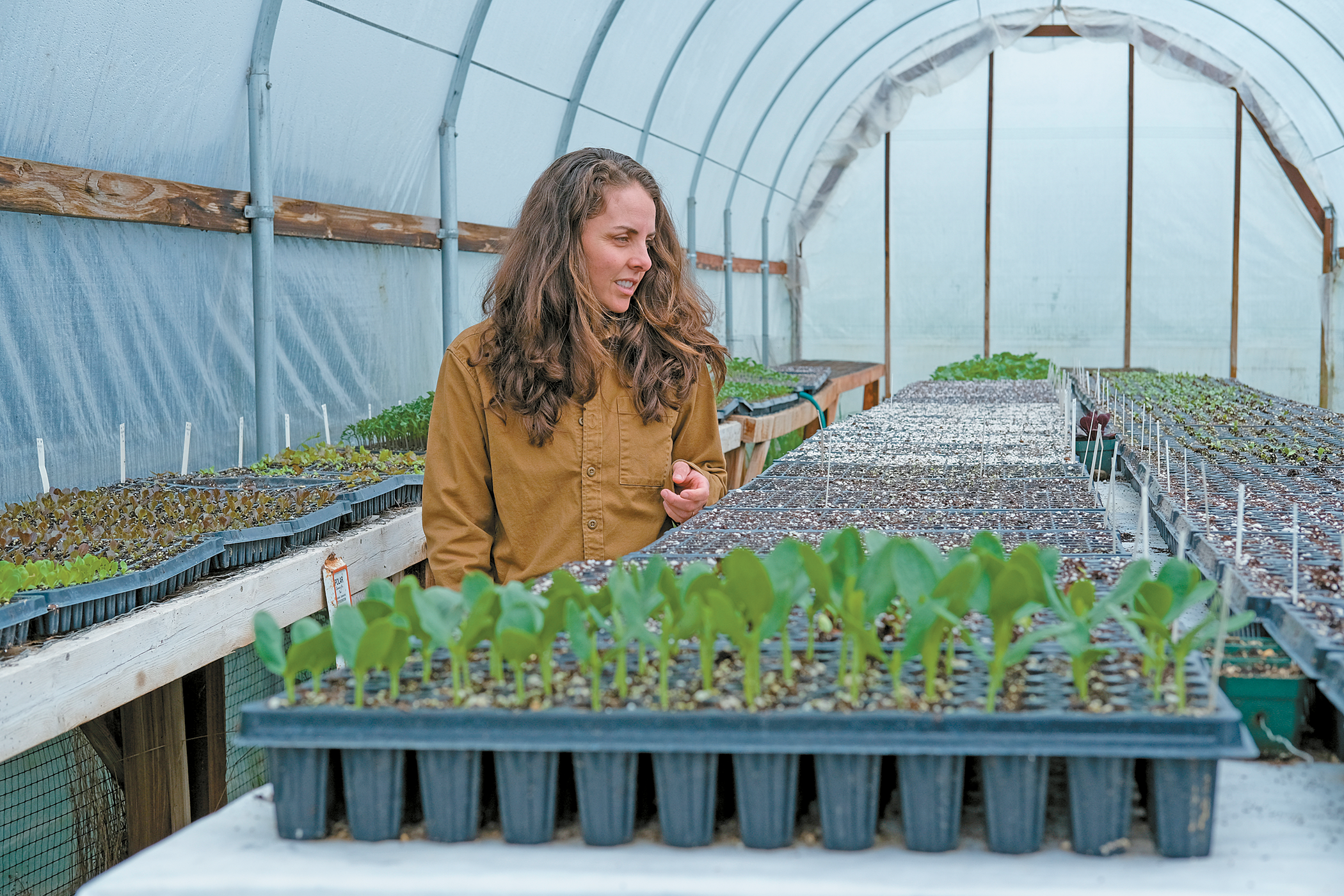Study finds benefit in clustering organics

Yolo County organic farmer Carine Hines and her dog, Akuna, walk along a hedgerow at Sun Tracker Farm in Capay Valley. A study by researchers from the U.S. and Canada found that organic pest control methods such as hedgerows are more effective when organic farms are clustered together.
Photo/Caleb Hampton


Photo/Caleb Hampton
By Caleb Hampton
A new study by researchers from the U.S. and Canada found that organic agriculture can increase pesticide use on nearby conventionally farmed fields.
The findings, based on data from Kern County, suggest that organic farms can further reduce their pesticide use when organic fields are clustered. But when organic acreage is interspersed among conventional fields, overall area-wide pesticide use can increase in some scenarios, researchers found.
The research could have impacts for farmers and policymakers worldwide as governments set targets for converting more farmland to organic agriculture.
“It might be worth considering at the policy level how to incentivize spatial clustering of new organic fields,” said Ashley Larsen, lead author and professor of agricultural and landscape ecology at the University of California, Santa Barbara.
The study, “Spillover effects of organic agriculture on pesticide use on nearby fields,” was co-authored by researchers from the University of Colorado, Boulder, and the University of British Columbia. It was published last month by the academic journal Science.
Until now, most research on organic farming has focused on the level of an individual field or farm. Seeking a clearer picture of the relationship between organic farms and overall pesticide use at the landscape level, the researchers analyzed crop and pesticide data collected from 2013 to 2019 on 14,000 fields in Kern County, which publishes more granular data than other counties.
The study found that the presence of surrounding organic cropland corresponded with a decrease in pesticide use on organic fields, with everyone benefiting, and to a “small but significant” increase in pesticide use on conventional fields.
The researchers hypothesized that nearby organic acreage impacted organic and conventional fields differently because of the different role beneficial species, or natural enemies, play on organic and conventional farms. While conventional farms use more powerful synthetic pesticides to control pests, many organic farms populate their fields with natural enemies as a form of pest control.
“Organic agriculture has higher populations of both natural enemies—or predators of pests—as well as pests,” Larsen said. When organic farms are surrounded by organic acreage, “perhaps that allows a larger and more stable natural enemy community,” she said. On the other hand, she said, “conventional fields might experience more of the negative effects because they have a smaller population of natural enemies.”
The implication, according to the researchers, is that the overall pesticide reductions from organic farming “materialize at higher levels of conversion to organic agriculture, or if organic agriculture is spatially concentrated.”
Their analysis found that when organic fields are randomly dispersed, changing from a baseline of no organic acreage to 5% organic results in a 9% increase in overall pesticide use at the landscape level. At higher levels of organic conversion, such as when 20% of the cropland in a landscape is organic and randomly dispersed, overall pesticide use declines by 17%.
However, when organic fields are clustered, the same conversion levels of organic acreage result in overall decreases in pesticide use by 10% and 36%, respectively, completely mitigating the negative spillover effects seen at low organic conversion rates when acreage is randomly dispersed.
After modeling these scenarios based on data from Kern County, the researchers broadened their analysis using nationwide data on county-level organic acreage and yearly pesticide use. They found the same “U-shaped” trend, with county pesticide use ticking up slightly at low organic conversion rates and dropping below baseline only after a higher percentage of cropland was converted to organic.
The findings come as state and world leaders seek to incentivize organic farming to meet ambitious goals. The European Union, where about 10% of farmland is organic, is aiming to expand organic agriculture to 25% of its farmland by 2030. California, also around 10% organic, plans to double the portion of its farmland that is organic by 2045. That would mean converting an additional 65,000 acres in the state.
The trends identified in the study, the researchers said, could help governments leverage the environmental benefits of organic agriculture when converting new acreage. “Perhaps there’s a way we can think about it at a larger scale to facilitate these beneficial spillover effects and limit the negative spillover effects,” Larsen said.
Carine Hines, an organic farmer in Yolo County and business advisor for small farmers in the region, said the research on spillover effects was welcome. She began farming in Capay Valley close to a decade ago because of the community of organic farmers in the area.
“It makes sense intuitively,” Hines, who has a Ph.D. in plant biology, said of the findings, though she pushed back on conclusions some might draw that organic farmers are responsible for pest control decisions made on conventional farms.
“We have to work towards finding ways to farm that balance the ecosystem and that are still productive in terms of crop yields,” she said, noting that organic agriculture, which cultivates biodiversity and organic soil matter for crop production, has environmental benefits such as carbon sequestration that are independent from pesticide concerns.
On her farm, where she grows tomatoes, squash, eggplants and other crops, Hines uses hedgerows and cover crops to provide habitat for beneficial species such as certain wasps, beetles, mites and birds, which act as a form of pest control. Surrounded by other organic farms in Capay Valley, her farm may be benefiting from extended habitat for those species on neighboring farms, according to the researchers.
“The whole concept is that you have biodiversity on your farm,” Hines said.
But farmers and agriculture experts cautioned that clustering future organic acreage could be hard to engineer at a policy level. “To cluster different farms from different owners in one location is very difficult to do in practice,” said Amrith Gunasekara, director of science and research for the California Farm Bureau and former manager of environmental programs for the California Department of Food and Agriculture.
Gunasekara said farms must respond to market forces to remain economically viable, with consumer behavior influencing cropping and farming decisions, including whether to convert conventional fields to organic or, in some cases, to convert organic fields back to conventional agriculture. “It’s so consumer driven,” he said.
Land access challenges for farmers may be another obstacle. “Especially in California, with how competitive and expensive land is, it’s really out of our hands to cluster organic farms,” Hines said. “More often than not, people have to farm whatever land comes their way.”
Still, without any policymaking, the study could inform individual farming decisions for growers who farm a mix of conventional and organic fields. “Trying to understand which current conventional field is surrounded by organics might indicate which field would most benefit from converting to organic agriculture,” Larsen said.
(Caleb Hampton is an assistant editor of Ag Alert. He may be contacted at champton@cfbf.com.)




